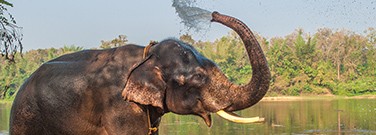Unpacking an Elephant’s Trunk: How It Uses Suction to Eat and Drink

By Gina Wynn
Elephant trunks are complex appendages that enable the enormous animals to taste, touch, smell, breathe, communicate, and even protect themselves. Engineers have taken note of the usefulness and versatility of the pachyderm’s multi-functional proboscis and have even built robotic trunk replicas.
Engineers from the Georgia Tech College of Engineering, led by Andrew Schulz, are hoping to take this a step further. They recently investigated how elephants use their trunks to manipulate air, water, food, and other objects, aiming to find out whether trunk mechanics could inspire the development of better, more efficient air-wielding robots.
They published their findings in the June 2, 2021, issue of the Journal of the Royal Society Interface.
Expanding Trunks
In collaboration with veterinarians at Zoo Atlanta and a 34-year-old female African elephant, the team conducted a variety of experiments, including ones that measure the speed of elephant suction and how much water a trunk could hold. They found that elephants can hoover up three liters of water per second — 30 times faster than a human sneeze. Pachyderms can also hold up to 5.5 liters of water by dilating their nostrils to create more space in their trunks, kind of like an expanding suitcase.
Finger Foods
The team also studied how elephants eat various foods. “An elephant eats about 400 pounds of food a day, but very little is known about how they use their trunks to pick up lightweight food and water,” said Schulz, according to the Georgia Tech College of Engineering article “How an Elephant’s Trunk Manipulates Air to Eat and Drink” by Jason Maderer.
They learned that for larger foods like rutabaga cubes, the elephant grabbed and collected them using the two finger-like ends of the trunk. For smaller cubes, the animal sucked them up, making a slurping sound, before transferring them to its mouth.
Nature’s Swiss Army Knife
The pachyderm also used suction to pick up a delicate tortilla chip. It either inhaled and used the end of its trunk to suck up the chip like a person might pick up a piece of paper with their mouth or applied suction from a distance like a vacuum cleaner to draw the chip toward its trunk.
“An elephant uses its trunk like a Swiss Army Knife,” said David Hu, professor in Georgia Tech’s George W. Woodruff School of Mechanical Engineering. “It can detect scents and grab things. Other times it blows objects away like a leaf blower or sniffs them in like a vacuum.”
Trunk Technology
These unique capabilities make the pachyderm proboscis the perfect model for robotic replicas. “By investigating the mechanics and physics behind trunk muscle movements, we can apply the physical mechanisms — combinations of suction and grasping — to find new ways to build robots,” Schulz said.
He also hopes that the insights he and other researchers gain about elephants and their trunks will help better conserve the creatures in the wild. Because of poaching and loss of habitat, the African elephant is on the endangered species list.
Discussion Questions
- What different methods do you use for eating and drinking?
- Why do you think elephants evolved with long trunks?
- Why do you think African elephants are on the endangered species list?
Vocabulary
- Pachyderm
- Proboscis
- Suction
- Manipulate

